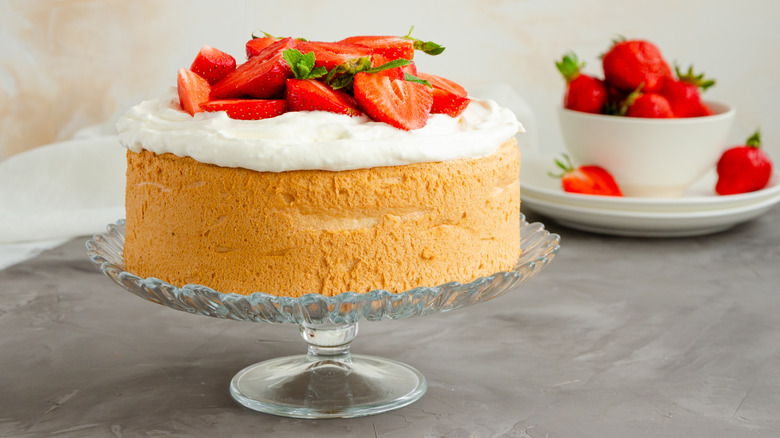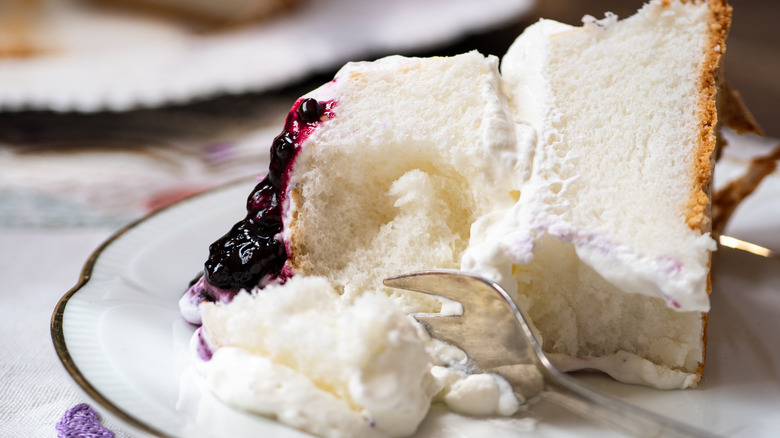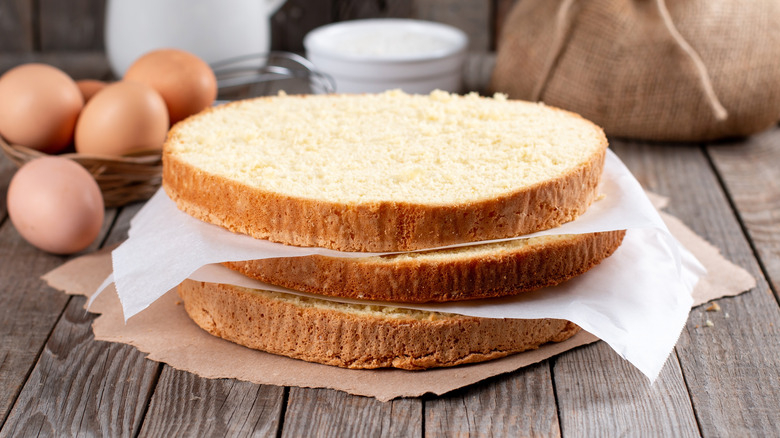The Key Difference Between Angel Food And Sponge Cake
Baking can be a precise and scientific culinary adventure, and knowing the subtle differences between two seemingly similar desserts can make all the difference in the kitchen. Take, for instance, angel food cake and sponge cake. These airy, light desserts have distinct flavors and textures, and these differences spring from the ingredients used and their preparation methods.
While angel food cake is a type of sponge cake, what sets it apart from most other sponge cakes is its delicate, melt-in-your-mouth texture and its distinctively light taste. Why is it oh-so-light and spongy? It's all in the eggs: Sponge cakes, in general, are made with whole eggs, while angel food cake only uses egg whites. This unique approach to baking means angel food cake is lower in calories, and has zero cholesterol and fat. So it's perfect for those who want the best of both worlds — a fluffy and tasty cake that won't weigh them down.
The differences between angel food cake and other sponge cakes don't stop at the eggs themselves. From the preparation techniques to the ingredients used, each cake has its own unique chemistry that makes it stand out. Whether you're a passionate home baker or a curious foodie, understanding these subtle nuances will help you perfect each recipe to suit your tastes and impress your dinner guests.
The heavenly secret behind angel food cake's fluffy texture
The secret behind angel food cake's lightweight texture lies in the baking technique. Unlike general sponge cakes that are typically used for layered cakes with buttercream, angel food cake doesn't rely on butter or oil to achieve its cloud-like texture. The magical technique that makes this treat so special is well-whisked egg whites that give it that pillowy softness.
The preparation process is crucial to achieving the perfect texture of this cake. Even the tiniest bit of yolk can affect the quality of the egg whites when they're whisked, so it's essential to keep the yolks out of the whites. For the best results, separate the yolks from the whites while they're still cold, as they'll separate more easily. Taste of Home says the perfect temperature for cold eggs in an angel food cake recipe is 60 degrees Fahrenheit.
Imperial Sugar suggests letting the egg whites sit out at room temperature — after separating them from the yolks — for about half an hour before whisking. This allows them to warm up and expand, which helps them to reach their full volume when beaten. Whisking them slowly and steadily is key to getting the right consistency. Once the whites are perfectly beaten, they create air pockets in the batter that give the cake its light, fluffy, melt-in-your-mouth texture.
What makes sponge cakes denser?
As you can see, sponge cake and angel food cake may appear to be similar at first glance, but the difference is in the details. While angel food cake is made by carefully folding in whipped egg whites, sugar, and flour, sponge cake takes a different approach. The egg whites and yolks are whipped separately to create a light and airy base, then combined with a pinch of salt and cream of tartar to create a cake that is both moist and a bit denser than angel food cake.
But what makes eggs so key to these cake textures? Neither of these cakes relies on baking soda or baking powder to achieve their unique texture. Instead, eggs are the secret leavening agent, helping the cakes rise and expand to heavenly heights. While they're used differently in each recipe, eggs contribute significantly to the structure and overall lightness of all types of sponge cakes.
When it comes to pairing each of these spongy cakes, it all depends on the occasion. Angel food cake's light and fluffy texture makes it an ideal choice for summer gatherings and outdoor picnics. Pair it with fresh berries or a dollop of whipped cream for a seasonal touch. Meanwhile, the denser, richer sponge cake is quite versatile, acting as the perfect base for a delicious buttercream-layered cake, cupcakes, or fondant-covered specialty cakes.


